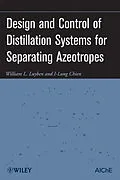Hands-on guidance for the design, control, and operation of
azeotropic distillation systems
Following this book's step-by-step guidance, readers learn to
master tested and proven methods to overcome a major problem in
chemical processing: the distillation and separation of azeotropes.
Practical in focus, the book fully details the design, control, and
operation of azeotropic distillation systems, using rigorous
steady-state and dynamic simulation tools.
Design and Control of Distillation Systems for Separating
Azeotropes is divided into five parts:
* Fundamentals and tools
* Separations without adding other components
* Separations using light entrainer (heterogeneous azeotropic
distillation)
* Separations using heavy entrainer (extractive distillation)
* Other ways for separating azeotropes
The distillation methods presented cover a variety of important
industrial chemical systems, including the processing of biofuels.
For most of these chemical systems, the authors explain how to
achieve economically optimum steady-state designs. Moreover,
readers learn how to implement practical control structures that
provide effective load rejection to manage disturbances in
throughput and feed composition.
Trade-offs between steady-state energy savings and dynamic
controllability are discussed, helping readers design and implement
the distillation system that best meets their particular needs. In
addition, economic and dynamic comparisons between alternative
methods are presented, including an example of azeotropic
distillation versus extractive distillation for the
isopropanol/water system.
With its focus on practical solutions, Design and Control of
Distillation Systems for Separating Azeotropes is ideal for
engineers facing a broad range of azeotropic separation problems.
Moreover, this book is recommended as a supplemental text for
undergraduate and graduate engineering courses in design, control,
mass transfer, and bio-processing.
Autorentext
WILLIAM L. LUYBEN, PhD, is a professor at Lehigh University. Dr. Luyben has published more than 220 technical papers in process control and design and is the author or coauthor of eleven textbooks. In addition, he has nine years of industrial experience, working with Exxon and DuPont.
I-LUNG CHIEN, PhD, is a professor at National Taiwan University of Science and Technology with research interests in design and control of chemical, polymer, and bio-processes. He was a senior consulting engineer for DuPont Engineering for nine years, where he performed research and consultation for various chemical processes. Dr. Chien has published more than fifty technical papers in process control and design.
Klappentext
Hands-on guidance for the design, control, and operation of azeotropic distillation systems
Following this book's step-by-step guidance, readers learn to master tested and proven methods to overcome a major problem in chemical processing: the distillation and separation of azeotropes. Practical in focus, the book fully details the design, control, and operation of azeotropic distillation systems, using rigorous steady-state and dynamic simulation tools.
Design and Control of Distillation Systems for Separating Azeotropes is divided into five parts:
-
Fundamentals and tools
-
Separations without adding other components
-
Separations using light entrainer (heterogeneous azeotropic distillation)
-
Separations using heavy entrainer (extractive distillation)
-
Other ways for separating azeotropes
The distillation methods presented cover a variety of important industrial chemical systems, including the processing of biofuels. For most of these chemical systems, the authors explain how to achieve economically optimum steady-state designs. Moreover, readers learn how to implement practical control structures that provide effective load rejection to manage disturbances in throughput and feed composition.
Trade-offs between steady-state energy savings and dynamic controllability are discussed, helping readers design and implement the distillation system that best meets their particular needs. In addition, economic and dynamic comparisons between alternative methods are presented, including an example of azeotropic distillation versus extractive distillation for the isopropanol/water system.
With its focus on practical solutions, Design and Control of Distillation Systems for Separating Azeotropes is ideal for engineers facing a broad range of azeotropic separation problems. Moreover, this book is recommended as a supplemental text for undergraduate and graduate engineering courses in design, control, mass transfer, and bio-processing.
Inhalt
PREFACE.
ACKNOWLEDGEMENTS.
PART 1 FUNDAMENTALS AND TOOLS.
1 INTRODUCTION.
1.1 History.
1.2 Applications.
1.3 Literature.
1.4 Multiple Steady States.
References.
2 PHASE EQUILIBRIUM.
2.1 Phase Equilibrium Relationships.
2.2 Equations Describing Phase Equilibrium Relationships.
2.3 Diagrams For Binary Systems.
2.4 Ternary Diagrams.
2.5 Data Regression.
2.6 Group Contribution Method.
2.7 Conclusion.
References.
3 STEADY-STATE DESIGN IN ASPEN PLUS.
3.1 Building a Steady-State Model.
3.2 Unit Operation Blocks Used in this Book.
3.3 Add a Nondatabank Component.
3.4 Conclusion.
References.
4 DYNAMICS AND CONTROL IN ASPEN DYNAMICS.
4.1 Sizing of Process Vessels.
4.2 Sizing of Pumps, Compressors, and Control Valves.
4.3 Controllers and Dynamic Elements.
4.4 Controller Tuning.
4.5 Ratio and Cascade Control.
4.6 Conclusion.
PART 2 SEPARATIONS WITHOUT ADDING OTHER COMPONENTS.
5 PRESSURE-SWING AZEOTROPIC DISTILLATION.
5.1 TetrahydrofuranWater System.
5.2 AcetoneMethanol System.
5.3 PentaneMethanol System.
5.4 Conclusion.
References.
6 PRESSURE SWING WITH HEAT INTEGRATION.
6.1 THFWater System Steady-State Design with Heat Integration.
6.2 THFWater System Dynamics and Control.
6.3 Heat Integration in an AcetoneMethanol System.
6.4 Conclusion.
References.
7 HETEROGENEOUS BINARY AZEOTROPES.
7.1 n-Butanol-Water System.
7.2 Phase Equilibrium.
7.3 Steady-State Design.
7.4 Dynamics and Control.
7.5 Conclusion.
References.
PART 3 SEPARATIONS USING A LIGHT ENTRAINER (HETEROGENEOUS AZEOTROPIC DISTILLATION).
8 ISOPROPANOLWATER (CYCLOHEXANE AS THE ENTRAINER).
8.1 Feasible Column Sequence for the Separation.
8.2 Steady-State Design of an IsopropanolWater System.
8.3 Overall Control Strategy Development.
8.4 Conclusion.
References.
9 ACETIC ACIDWATER (ISOBUTYL ACETATE AS THE ENTRAINER).
9.1 Comparison of Three Candidate Entrainers.
9.2 Control Strategy Development.
9.3 Industrial Column with Preliminary Dynamic Simulations.
9.4 Industrial Column with Continuous Side-Stream Draw Off.
9.5 Side Draw with a Practical Automatic Purging Strategy.
9.6 Conclusion.
References.
PART 4 SEPARATIONS USING HEAVY ENTRAINER (EXTRACTIVE DISTILLATION).
10 ISOPROPANOL-WATER (DIMETHYL SULFOXIDE AS THE ENTRAINER).
10.1 Comparing Entrainers: Dimethyl Sulfoxide Versus Ethylene Glycol.
10.2 Steady-State Design and Economical Analysis.
10.3 Overall Control Strategy Development.
10.4 Con…
